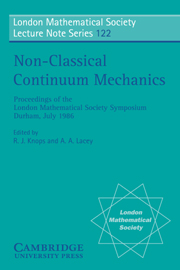 Non-Classical Continuum Mechanics
Non-Classical Continuum Mechanics Book contents
- Frontmatter
- FOREWORD
- Contents
- LIST OF PARTICIPANTS
- PART I PRINCIPAL LECTURES
- PART II SINGLE INVITED LECTURES
- Some Mathematical Problems Arising From the Oil Service Industry
- Randomly Diluted Inhomogeneous Elastic Networks near the Percolation Threshold
- Adaptive Anisotropy: An Example in Living Bone
- Stability of Elastic Crystals
- Optimal Bounds for Conduction in Two-Dimensional, Two-Phase, Anisotropic Media
- Rapid Flows of Granular Materials
- The Constrained Least Gradient Problem
- The Fusion of Physical and Continuum-Mechanical Concepts in the Formulation of Constitutive Relations for Elastic-Plastic Materials
- Singularities in Elliptic Non–Smooth Problems. Applications to Elasticity
- Solitons in Elastic Solids Exhibiting Phase Transitions
- On the Dynamics of Structural Phase Transitions in Shape Memory Alloy
- On the Homogenization of Some Free Boundary Problems
- The Point Interaction Approximation, Viscous Flow Through Porous Media, and Related Topics
Solitons in Elastic Solids Exhibiting Phase Transitions
Published online by Cambridge University Press: 11 May 2010
- Frontmatter
- FOREWORD
- Contents
- LIST OF PARTICIPANTS
- PART I PRINCIPAL LECTURES
- PART II SINGLE INVITED LECTURES
- Some Mathematical Problems Arising From the Oil Service Industry
- Randomly Diluted Inhomogeneous Elastic Networks near the Percolation Threshold
- Adaptive Anisotropy: An Example in Living Bone
- Stability of Elastic Crystals
- Optimal Bounds for Conduction in Two-Dimensional, Two-Phase, Anisotropic Media
- Rapid Flows of Granular Materials
- The Constrained Least Gradient Problem
- The Fusion of Physical and Continuum-Mechanical Concepts in the Formulation of Constitutive Relations for Elastic-Plastic Materials
- Singularities in Elliptic Non–Smooth Problems. Applications to Elasticity
- Solitons in Elastic Solids Exhibiting Phase Transitions
- On the Dynamics of Structural Phase Transitions in Shape Memory Alloy
- On the Homogenization of Some Free Boundary Problems
- The Point Interaction Approximation, Viscous Flow Through Porous Media, and Related Topics
Summary
Abstract. Among elastic crystals which are subjected to phase transitions are those which represent so-called ferroic states. These are elastic ferroelectrics, elastic ferromagnets and ferroelastic crystals such as twinned shape-memory materials. In these three wide classes studied by the author and co-workers, the solitary waves which can be shown to exist and represent either moving domain walls or nuclei of transformations, are not true solitons since the interaction of two such waves always is accompanied by some linear radiation. This is a consequence of the very form of the governing systems of equations which may be of different types (e.g., sine-Gordon equation coupled to wave equations, modified Boussinesq equation) and are usually obtained either from a discrete lattice model or a rotationally invariant continuum model. For the sake of illustration the case of shape-memory materials is presented in greater detail through the first approach.
INTRODUCTION
Nearby, but below, the order-disorder phase-transition temperature, the dynamical equations that govern elastic crystals with a microstructure exhibit all the necessary, if not sufficient, properties (essentially, nonlinearity and dispersion with a possible compensation between the two effects) to allow for the propagation of so-called solitary waves. Whether these are true solitons or not is a question that can be answered only in each case through analysis and/or numerical simulations. These waves, however, are supposed to represent domain walls in motion. The latter are layers of relatively small thickness which carry a strong nonuniformity in a relevant parameter between two adjacent phases or degenerate ground states (see, e.g., Maugin and Pouget, 1986).
- Type
- Chapter
- Information
- Non-Classical Continuum MechanicsProceedings of the London Mathematical Society Symposium, Durham, July 1986, pp. 272 - 283Publisher: Cambridge University PressPrint publication year: 1987
- 4
- Cited by


